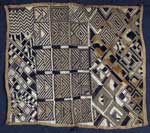VAM galleries including this work:
Berea College | Do You See a Pattern? | Art Through Time || VAM Home
KUBA CLOTH (KASAI VELVET), 19th century
African, Zaire
Raffia cloth; 16-1/2" X 19-1/2"
220.W.244
By permission of Berea College
Raffia, a fiber derived from African palm trees, is the basic material used in the creation of Kuba cloth. Kuba cloth is also known as Kasai velvet, after the Kasai region of Zaire (now the Democratic Republic of Congo) in which it originated. Examples of Kuba cloth date as far back as the 17th century. These highly regarded cloths were often made for royalty and were sometimes buried with the deceased. Artists Henri Matisse, Gustav Klimt, and Paul Klee are among those who have collected Kasai velvet, and the timeless beauty of Kuba cloth still holds strong appeal for modern audiences.
About the Kuba Artists and Process
Kuba cloth is traditionally produced in a collaborative effort between men, who use a loom to weave palm fibers into a mat, and women. The mat is soaked in cold water and beaten in order to soften it, and tufts of the material are clipped to create a velvety pile. Although men sometimes decorate the cloth they weave, only women produce the most laborious and prestigious type of cloth decoration, cut-pile embroidery. It can take a month to complete a small square of Kuba embroidery using a technique that includes dyeing, detailed needlework, and clipping individual tufts. Except for novices, crafters create their designs as they work, often creating new combinations from familiar metalworking, mat making, and women’s body scarification. Kuba artists favor an improvisational, fluid effect that plays with deliberate asymmetries and pattern variation, creating the cloth’s distinctive and exquisite workmanship.
Classroom Ideas
Discussion: At the library or online, research the art of Matisse, Klimt, and Klee. What about Kuba cloth might have appealed to these artists? Do you see any similarities between their art and the geometric designs of the Kuba cloth?
Activity: Use plastic stitchery canvas (37 holes per inch) or a piece of cloth, heavy-gauge colored yarn, and a large needle to create your own weaving. Visualize an attractive pattern in your mind and try to re-create it on the canvas without using a drawing as a guide.
Links
Visit the “Costumes and Textiles” section of the Diversity of African Art pages from the Smithsonian Institution’s National Museum of African Art and select Kuba for more information and examples of Kuba cloth.
[www.nmafa.si.edu/pubaccess/pages/divfrm.htm]
The following galleries also contain information and examples:
- The African Conservancy
[www.africanconservancy.org/member/kuba.html] - Hamill Gallery
[www.hamillgallery.com/KUBA/KubaTextiles.html] - Art from Africa
[www.artfromafrica.com/kasaivelvet.htm]

